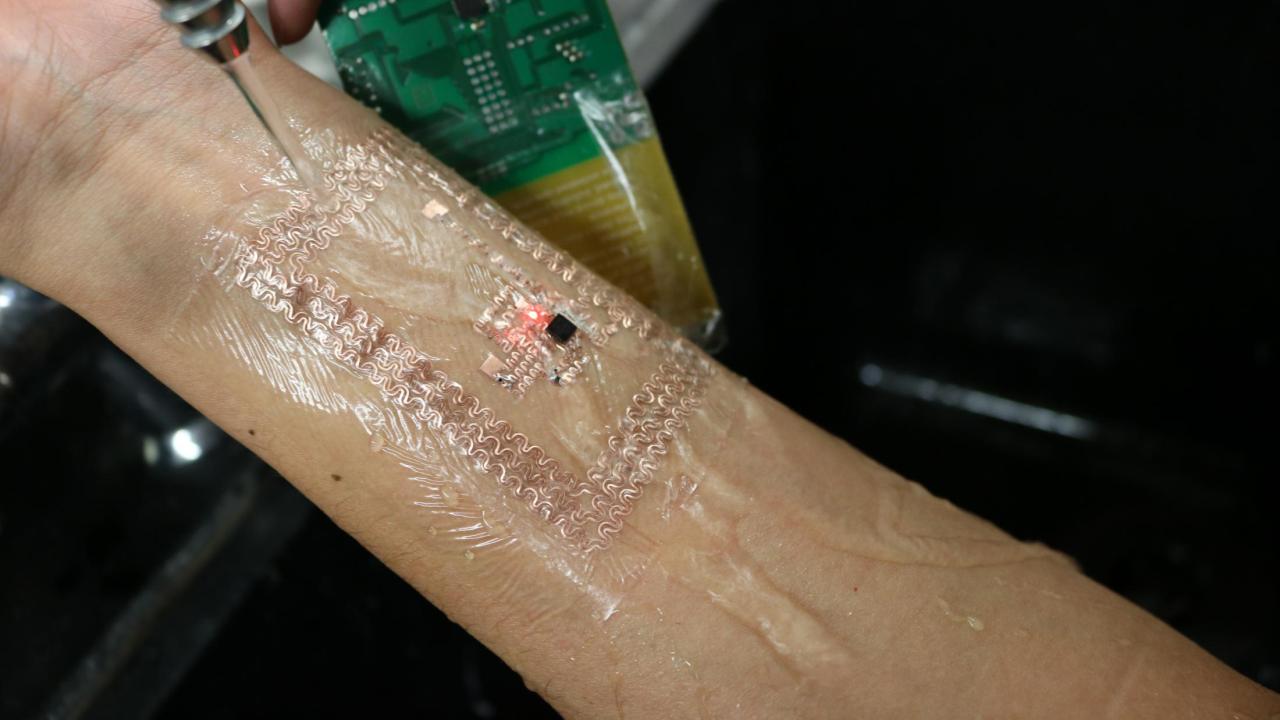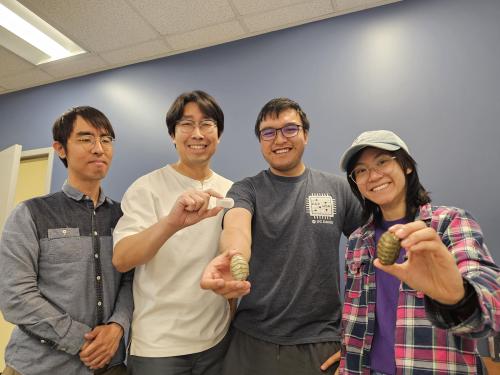
Using Wearable Devices for Diagnostics, Prevention and Therapeutics
While smartphones and smartwatches can track basic health stats like heart rate, Assistant Professor of Electrical and Computer Engineering Hyoyoung Jeong envisions a future of skin-close wearables that capture a broader picture of health.
Jeong became interested in skin-conforming wearable devices for health monitoring while working at Samsung, where he and his team developed a blood pressure estimation function for the company's Galaxy smartwatch.
"Using a device like a watch, it's really hard to collect clean data because the wristband is affected by the motion when the wearer moves their hand," Jeong explained. "I wanted to start making skin-interfaced devices, which are more attached to the skin than a wristband."
Jeong has since researched and developed several wireless wearables, exploring the diverse potential of the technology and how it could impact medical practicality, accessibility and economy.
Convenient Treatment and Recovery
Jeong aims for his wearables to be comfortable and convenient, requiring minimal intervention from the user.
For example, in 2020, Jeong and other researchers partnered with the U.S. Department of Health & Human Services' Biomedical Advanced Research and Development and health monitoring technology company Sibel Health to deploy wearable devices to COVID-19 patients. The study explored home options for health monitoring to account for already strained hospital resources.
The device uses a thin sensor on the base of the neck to record heart rate, body temperature and respiratory activity like coughing frequency and intensity. It automatically collects and uploads this data to a cloud server, where an algorithm converts the data into easy-to-use information for the patient's physician.
"Many patients were very sick and kept coughing, so they couldn't control the device using their smartphone, so the simplicity is very important," Jeong said. "The patient just needs to wear the device, and everything else is automated."
Monitoring for Prevention

In 2023, Jeong developed a wearable device to assess a user's risk for vocal fatigue, consisting of a thin device that conforms to the skin on the upper chest. This device uses a mechano-acoustic sensor, which measures the signal of the user's vocal fold vibrations. Then, through a machine learning algorithm, the data is presented on a graphical interface on the user's smartphone.
"I utilized the wearable device and machine learning to classify various vocal-related activities, including speaking, singing, coughing and laughing," Jeong explained. "With this platform, my team helped professional singers monitor their vocal status quantitatively."
The platform also provides haptic feedback through a separate actuator, a small device worn on the wrist. The actuator initiates a slight vibrating alert when the sensor detects an uptick in vocal intensity or pitch, which may indicate increasing fatigue.
Incorporating Implantables for Therapeutics
Jeong also explores the therapeutic use of wearables for post-surgery patients to reduce the need for more invasive monitoring and extended hospital stays.

In 2022, Jeong's team developed a system to control and monitor cardiac rhythms and provide haptic feedback for cardiovascular surgery patients. This system combines wearable devices with an implantable pacemaker. The pacemaker is resorbable, meaning the materials can be absorbed into a patient's body.
"After one month or a year, the pacemaker can naturally disappear," Jeong said. "We don't need any additional open-chest surgery for removal."
This implantable system addresses one current limitation of wearable technologies: because they are attached to the skin, their sensors are generally limited to external signals.
"Most of the current application is monitoring surface data like skin hydration, surface electrical signals or surface optical signals," Jeong explained. "If we use implantable and wearable devices together, then we can find more available target signals, which creates more available functions for these devices."
Economy and Outlook
At first, a compact device that can accomplish a range of monitoring and feedback functions might seem even more expensive than current technology. Jeong, however, believes that these devices can be more cost-efficient.
Compared to bulky hospital machinery, wearable devices require significantly less material, making them generally cheaper to manufacture. For example, the COVID-19-monitoring device deployed by Jeong's team in 2020 requires a single chip and can be manufactured for around $15 to $20.
"The most important goal is to reduce medical expenses, which means anyone can use this platform: low-income, middle-income or high-income," Jeong said.
Jeong believes the field of wearable technology will continue to grow alongside public health consciousness and healthcare costs. According to the American Medical Association, Americans spent $4.5 trillion in healthcare in 2022, with 30 percent of that total going towards hospital care.
"Everyone is thinking about their health more and more, and medical expenses are increasing," Jeong said. "I think there will be a demand for a cheaper or easier way to monitor health, which would be wearable technology."
Expanding Use
As he continues designing these wearable devices, Jeong looks to continue to enhance and expand the applications of wearable technology.
Jeong is interested in expanding the use of wearable technology to animals. Last year, he initiated a project with the Bodega Marine Laboratory. Starting with tiny sea creatures like chiton and abalone, this research project focuses on developing wireless sensors and verifying their ability to effectively operate underwater, which would determine the possibility of expanding these monitoring devices to larger marine animals in the future.

The interdisciplinary project aims to equip researchers with effective methods for the observation — and, therefore, protection — of endangered marine species, explained electrical and computer engineering graduate students Noah Nguyen and Jan Truong, who work on the project in Jeong's lab.
This project is one illustration of how Jeong uses his expertise in wearable technology to work with colleagues from across UC Davis on interdisciplinary projects.
Another example is an ongoing project with Stavros Vougioukas, professor and vice chair of the Department of Biological and Agricultural Engineering, that explores how wearable devices can work alongside harvesting robots to monitor the overall health status and ensure the safety of farm workers while also maintaining the efficiency needed for the harvesting process.
"The College of Engineering really promotes a culture of collaboration," Jeong said. "It's an environment that doesn't just allow but actively encourages innovative thinking and interdisciplinary projects. It's one of the reasons I'm so excited about the future of our research here."

